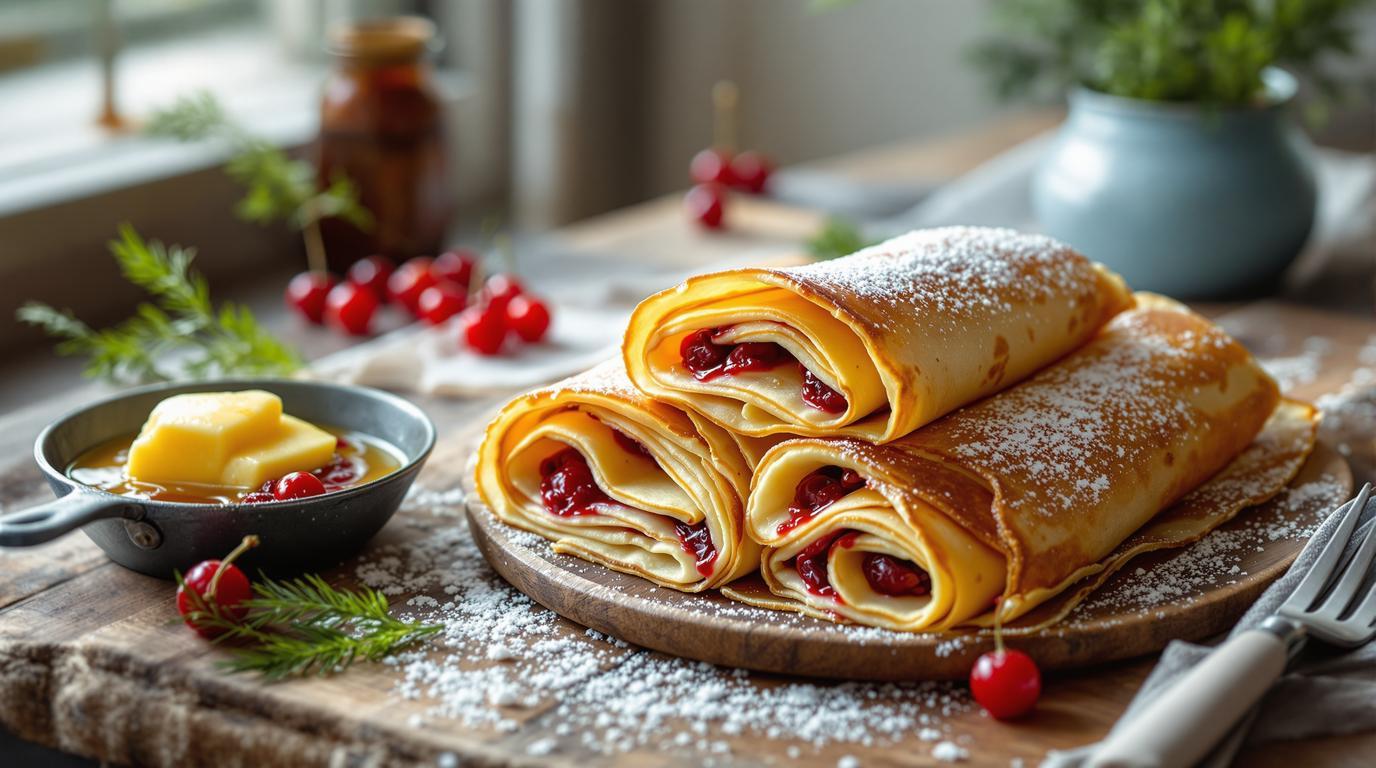When I was a young chef training in Stockholm, my host mother would wake before dawn to prepare plättar—those delicate Swedish pancakes that somehow manage to be both hearty and light as air. The sizzle of butter hitting the cast iron pan was my alarm clock, and the earthy aroma filling our small apartment was better than any cup of coffee. Years later, I’ve adapted her recipe to include either chickpea or oat flour, dramatically boosting the protein content while honoring the traditional technique. These aren’t your typical thick American pancakes—they’re thin, pliable, and perfect for rolling around sweet or savory fillings. 🇸🇪
The Story Behind Swedish Protein Pancakes 📖
Swedish plättar date back centuries, traditionally made with simple ingredients available even during harsh Nordic winters. What makes this adaptation special is how it preserves the delicate texture of authentic Swedish pancakes while incorporating protein-rich alternatives to white flour. This isn’t a modern “protein pancake” that sacrifices texture for nutrition—it’s a beautiful marriage of old-world technique and contemporary nutrition science.
While developing this recipe, I was reminded of the Mediterranean approach to protein-packing traditional recipes—simple adjustments that honor culinary heritage while making dishes more nutritionally complete.
Essential Ingredients 🧾
- 4 large eggs (room temperature for better incorporation)
- 8 oz (227g) cottage cheese (4% milk fat preferred for flavor)
- ½ cup (120ml) milk (whole milk creates the richest texture)
- ½ cup (60g) oat flour OR ⅓ cup (40g) chickpea flour
- ¼ cup (60ml) butter or oil, plus more for cooking
- 1 teaspoon vanilla extract
- ½ teaspoon salt
Chef’s Note: Chickpea flour creates a more protein-dense pancake with an earthy flavor profile that pairs beautifully with savory fillings. If using chickpea flour, you may need to add 1-2 extra tablespoons of milk, as it absorbs more liquid than oat flour.
Step-by-Step Instructions 📝
1. Prepare Your Batter: Add eggs, cottage cheese, milk, your chosen flour, melted butter (or oil), vanilla, and salt to a blender. Pulse until completely smooth—about 30-45 seconds. The batter should be considerably thinner than American pancake batter, closer to the consistency of heavy cream.
2. Rest the Batter: Allow batter to rest for 5 minutes. This gives the flour time to hydrate properly and the gluten to relax, resulting in more tender pancakes.
3. Heat Your Pan: Place a well-seasoned cast iron skillet or non-stick pan over medium heat. When a drop of water dances across the surface, you’re ready to begin. Add a small amount of butter or oil.
4. Cook with Precision: Pour approximately 3 tablespoons of batter into the pan, quickly tilting to spread it into a thin circle about 5 inches in diameter. Cook until the edges begin to dry and curl slightly, about 2-3 minutes.
5. Master the Flip: When bubbles form on the surface and the edges look set, gently slide a thin spatula underneath and flip with confidence. Cook for just 1-2 minutes more—overcooking will make them less pliable for rolling.
Chef’s Secret Techniques 🤫
The key to perfectly thin Swedish pancakes lies in the pour and tilt. As soon as the batter hits the pan, lift and rotate the pan to spread the batter in a circular motion. This technique—rather than using a spatula to spread—ensures even thickness.
For a lighter version, consider adopting the technique I use in my protein-packed breakfast recipes, substituting cooking spray for butter when preparing the pan.
If you’re struggling with tearing during flipping, let the pancake cook slightly longer on the first side. Patience pays dividends here—rushing the flip is the most common mistake I see in my cooking classes.
Serving & Presentation Tips 🍽️
Traditional Swedish pancakes are served rolled, not folded or stacked. For an authentic experience, spread a thin layer of lingonberry jam inside each warm pancake and roll it into a cigar shape. Dust with powdered sugar or top with a dollop of whipped cream.
For a savory twist, fill with smoked salmon, a touch of cream cheese, and fresh dill—a combination that showcases the Nordic flavor palette beautifully. The protein-rich base pairs wonderfully with the Mediterranean flavor profiles of summer, too.
These pancakes actually travel well for lunch boxes or picnics—simply roll them around your filling of choice, wrap in parchment paper, and twist the ends closed. The pliable texture prevents cracking, unlike brittle crepes.
In my restaurant days, we would prepare a platter with a variety of rolled pancakes—some with berry compote, others with savory fillings—creating a beautiful communal dining experience. Consider this approach for your next brunch gathering.
Like the brilliance of simple Asian noodle preparations, these pancakes remind us that sometimes the most satisfying dishes are also the most straightforward. The simple act of rolling these delicate pancakes around a filling of your choice transforms humble ingredients into something truly special—a testament to the genius of traditional Nordic cooking.
